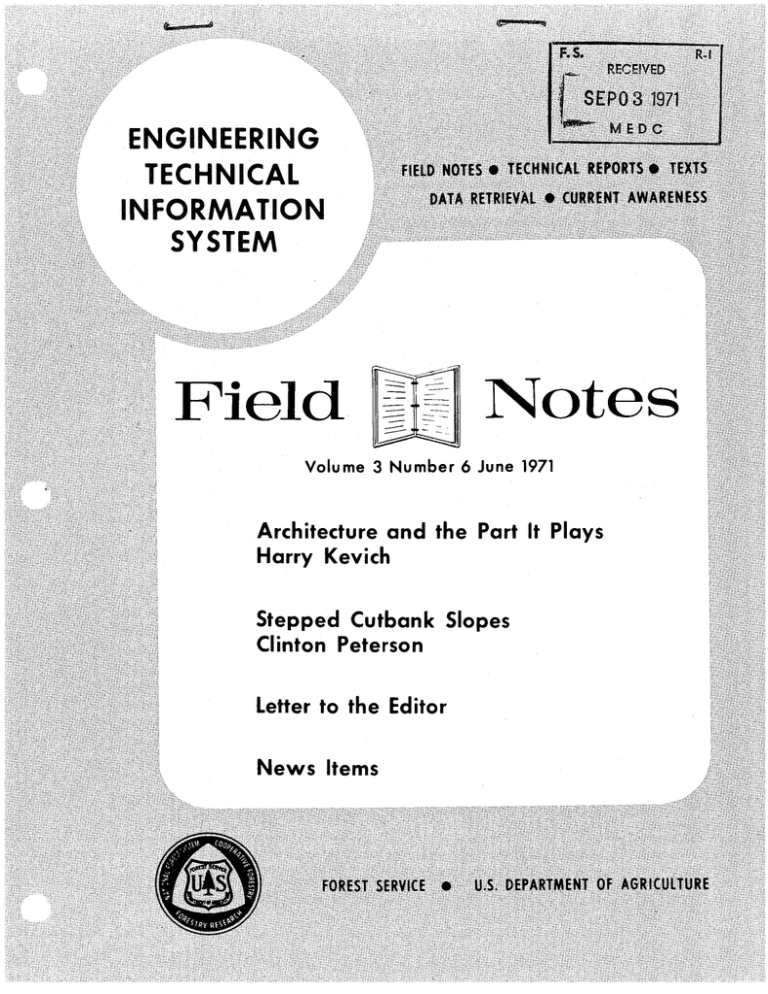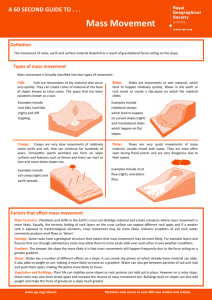Notes Field ENGINEERING TECHNICAL
advertisement

ENGINEERING TECHNICAL INFORMATION SYSTEM Field Notes Volume 3 Number 6 June 1971 Architecture and the Part It Plays Harry Kevich Stepped Cutbank Slopes Clinton Peterson Letter to the Editor News Items ENGINEERING FIELD NOTES This publication is a m.onthly newsletter published to exchange Engineering inform.ation and ideas am.ong Forest Service personnel. The publication is not intended to be exclusive for engineers. However, because of the type of m.aterial in the publication, all engineers and engineering technicians should read each m.onthly issue. The publication is distributed from. tile Washington Office directly to all Forest, Regional, Center, Station, Area, Laboratory, and Research Offices. Adequate copies are printed to provide all who wish a personal copy. If you are not now receiving a personal copy and would like one, ask your Office Manager or the Regional Inform.ation Coordinator to increase the num.ber of copies sent to your office. Use form. 7100-60 for this purpose. Copies of back issues are also available from. the Washington Office and can be ordered on form. 7100-60. It is intended that the m.aterial in the Field Notes be prim.arily written and used by Forest Service Field Engineers; however, m.aterial from. other publications m.ay be used. Field Note m.aterial should always be inform.ative and cannot contain m.andatory instructions or policy. The length of an article m.ay vary from. several sentences to several typewritten pages. Material need not be typed (neatly written or printed is acceptable), or edited before being subm.itted to the Washington Office. This will be done in the Washington Office to accom.·m.odate our form.at and allowable space. Each Region has an Inform.ation Coordinator to whom. field personnel should subm.it both questions and m.aterial for publication. The Coordinators are: R-l R-2 R-3 R-4 R-5 Alfred Buerger Dan Roper Fleet Stanton Chuck Paletti Kjell Bakke R-6 R-8 Ernest Quinn R-9 Clifford Hill R-lO Loren Adkins WO Inform.ation contained in this. report has been developed for the guidance of em.ployees of the U. S. Departm.ent of Agriculture - Forest Service,its contractors and its cooperating Federal and State agencies. The Departm.ent of-Agriculture assum.e~ no responsibility for the interpretation or use of this inform.ation by other than its Own em.ployees. The use of trade, firm., or corporation nam.es is for the inform.ation and convenience of the reader. Such use does not constitute an official evaluation, conclusion, recom.m.endation, endorsem.ent, or approval of any product or service to the exclusion of others which m.ay be suitable. FIELD NOTES ARCHITECTURE AND THE PART IT PLAYS 1) by Harry Kevich, Architect, Region 5 Before launching into the specifics of my topic, I first want to establish a realistic perspective of architecture and environment within the framework of Forest Service activity. I believe for all of us, the relevance of environment has been an integral part of our awareness. Only recently has the environment assumed a broad new dimension. Years ago, what we now call the environment was called II Conservation, II and it was basically oriented towards the back country - - the forests. The environmental movement of the Seventies begins where the worst environments are, and moves outward - - from the slums to the wi1dernes sand not vice versa. Our forests become a narcotic of sorts because they suggest that not much is wrong with the American environment. But we know there is a great deal wrong because we see beyond the scenic highways and the tended recreation areas. The realistic perspective of architecture in the Forest Service, I somewhat hesitantly admit, does assume lesser significance within the total environmental scene. Even simple awareness can only logically bring us to this conclusion. If we are not actually exposed to the cities, the news media increasingly focus our attentions on the urban crisis. In the cities architecture assumes primary involvement in the attempts to resolve the prob~ems of contemporary society in terms of the physical environment. And, the problems are horrendous and vastly complicated. Money and technology could eventually clean the air and water and provide adequate transportation systems which satisfy the needs of the people. But, the living environment, the housing and the slum clearance imply much more than just money and technology can resolve. In housing we deal most intimately with people and their needs and desires. We have seen examples of public housing constructed in the recent decades fail miserably because they, in failing to meet the needs of the people, have become virtual slums. The architects are aware of this and are groping for new solutions. 1/ Excerpts from talk given by Harry Kevich at the Environmental Workshop for Engineered Facilities in Marana, Arizona, April 20-23, 1971. I I will now move to the forest scene and align our perspective with reference to the role of architecture. Our environmental concern here, in main, deals with conservation, preservation, protection, and pollution, both physical pollution and visual pollution. It is the latter, the visual pollution, that will illustrate my point. You have already or will discuss roads, public utility services, and timber harvesting procedures, all of which separately and/or together have tremendous visual impact on the natural landscape. By comparison, the buildings we construct are generally dispersed, small in scale, and toa large extent only momentarily viewed by a moving automotive society. In terms of environmental considerations, Forest Se rvice buildings intrude minimally on the landscape; they don't have an overwhelming or continuing visual impact. I cannot think of an instance when a conservation group has criticed us for lack of environmental concern in the construction of our facilities. In setting a perspective of architecture in the Forest Service, it may seem that I am negating the importance of our facility designs. This is not my intent. I have attempted,. hopefully with objectivity, to relate the priorities as I see them and not be confused or influenced by a subjective professionalism. Certainly, architecture is important to me but so are the other things I have mentioned as well as those other subjects you are addressing yourselves to this week. It is Illost appropriate that my topic appear on the" People and Environment" portion of the program because that in a nutshell is what architecture is all about. We are in a unique position in the Forest Service in that we can dedicate ourselves to design structures according to classic human values and under conditions that are rarely available to others. We have magnificent land. We can design for people and environment, unencumbered by political interference, profit motives or antiquated traditions. There may be some exceptions or constrains but I suspect that most of these . are self-imposed. Because we have a broad latitude of freedom in design we must exercise greater responsibility towards the environment in the concepts we propose. These concepts relate to two basic areas of consideration: visual impact and human invol vement. 2 The first, visual impact, is highly subjective and dependent on the creative talents of the design architect. He often hears the phrase, "blend the buildings into the natural environment. 11 But what does this mean? We know that, to be functional, no building can or should imitate forms of trees or rocks or whatever. A building will always be different from that which naturally exists around it. What we seek is a compatibility of design with environment that will meet public acceptance since it is the public who is our ulti mate client and user. Our toilet structures in heavily timbered campgrounds diminish in scale because of a high tree canopy, and if finished in-natural wood materials almost fade into the background. Would this same type toilet be compatible at a lakeside recreation site where the ground cover may be only sand and grass? Unlike the timbered site toilet, it will dominate the site just because it is there. We could be adventurous and depres s the structure below the natural grade which would seemingly leave the site in its original state. But this would create operation and maintenance problems which we all obviously seek to minimize. We therefore recognize that we will impose on a site a structure which will have great visual impact. This impact would not necessarily have to be negative if the architect weighs the alternatives. The structure can be sculpted into a pleasing form where the play of light and shadow cause it to become a desirable focus. Or it could be a playful structure with color and form expres sive of the activities of the people in the immediate environment. My experiences lead me to suggest that there is a broad area of divergent opinions as to what is compatibility of design to environment. The layman will not necessarily think of it in this sence; he will respond to a building either positively or negatively in varying degrees dependent on his personal involvement and past experiences. It is this element of past experience which is most significant, because experience allows us to feel comfortable and accepting. For example, I think we would all agree that for a timber alpine site, rustic heavy timber construction with exterior finishes of wood and native stone would be most appropriate. At this moment, I am sure all of us can conjure an image, based on our personal experiences, of-how a building of this type has appeared in any number of given locations. And we feel very comfortable with this image because it is a part of our experience. Now, take this one step further to an alpine site where no 3 buildings exist but are proposed. You might anticipate the architect would present concepts pretty much conforming to the images of your past experience. But if the al;'chitect, using the same structural materials and exterior finishes, chooses to express his concept in bold new forms you may not feel comfortable and may tend to reject his proposal - - not because it imposes on the environment but because it is different. I have directed my comments wholly towards external considerations which is only part of the architectural proces s. The internal is also environment but more related to my second area of consideration-human involvement. The architect's experience will indicat~ that few, if any, design concepts will be succes sful without involvement of and interaction between people. We know that those people who are the actual recipients of the architect's services are actively concerned about every pencil line he draws. The architect cannot even begin until he is given design criteria. If he determines that certain information is lacking, he can rightly expect it to be provi4ed to him upon request. He makes only design decisions, not management decisions. It is during this process of supplying information that the interplay of people begins. People express ideas, deSires, and needs that make them physically and mentally comfortable· within a working, living or recreating environ·ment. The architect responds to all of this and in turn, suggests other ideas for their consideration. This whole process can be extremely dynamic and gratifying to all concerned, which inspires the creative efforts 0:£ the architect •. He is not relegated to sitting in a removed office cranking out drawings on the drafting table for faceless persons at unknown distant locations. How could this latter situation evoke any environmental consciousness? I've talked about the needs for our own facilities - - those that we use ourselves. But, how about the facilities we provide for the public? They too have a voice and express themselves -- perhaps for our purposes, much too loud and too often. But we have the responsibility of listening to them and recognizing wherein their comments are valid. Somehow, all this feedback must filter back to the architect. He must interact with those persons within the 4 organization who are the recipients of public opinion. He is then more ably equipped to incorporate this information into his future planning. At this point, in front of this open forum, I am prepared to attack the "Sacred Cow" of Forest Service architecture -- the standard building plan. I cannot conceive of how this procedure, created sometime in the dark ages, can in anyway be compatible with our commitment to environmental consciousness. These standards begin by immediately setting constraints on optimal site selection and site development. We are forced to seek a flat section of land or even worse, we desecrate a site so that it will accommodate the pre-ordained building. The natural vegetation is totally removed, taking years to recover and in areas of fragile ecology, probably not recover at all. I stated earlier that we are uniquely fortunate in that we manage magnificent land. Isn't it simple logic that when at all pos sible we preserve and enjoy what we have? Where is there any semblance of human involvement? The recipient thumbs through his latest catalog, selects that design which most closely meets his criteria solely in terms of space and orders accordingly. He eventually receives the keys to a totally impersonal structure devoid of any character which only people and their mutual input can cause it to have. And what of design? A basic precept of architecture is that building concepts develop from site considerations and not vice versa. I believe the classic example is best described by a picture most of you must have seen of the Frank Lloyd Wright design house entitled" Falling Water" in Pennsylvania. Somehow we got into one colossal box designing nothing but boxes which have been rehashed and perpetuated for decades. And we continue to impose these on the landscape, and paint them a standard brown and struggle to maintain them. In short, we have created Forest Service slums! In his current best seller, "The Greening of America," Charles Reich says, "Technology and production can be great benefactors of man, but they are mindless instruments; if undirected they career along with a momentum of their own. In our county they 5 pulverize everything in their path; the landscape, the natural environment, history and tradition, the amenities and civilities, the privacy and spaciousness of life, beauty, and the fragile, slowgrowing social structures which bind us together. Organization and bureaucracy, which are applications of technology to social institutions, increasingly dictate how we shall live our lives, with the logic of organization taking precedence over any other values. " Perhaps our position has relied too heavily on the security of the past, but to some degree this is quite natural and in fact essential - - it is part of the growth process. But this reliance on past security significantly contributes to another phenomenon of today -- the "generation gap. 11 In an age when events moved slowly, the youth could revere, accept, and gain from the experiences expounded by their elders. Indeed, the elders 1 experiences are our reservoir of knowledge without which much of the new knowledge is meaningless. The condition was such that time allowed an older generation to leave the scene and in t~rn allowed a new group to enter or move up and implement some change. The pace of events today is awesome, and our youth are reluctant to play the waiting game. In spite of all the adverse publiCity relating to the youth in our institutions, we know that the vast majority are more aware, more responsive, more knowledgeable and probably more capable than we were at a simil(;l.r age. They more readily recognize that environment is not solely, or even in large part, ecology. The other forces - - social, economic, and political - - have significant impact, although probably more subtle. I would suggest that we, to perpetuate a viable and dynamic organization, must find the means to effect a meaningful unity of experience and fresh knowledge into a functional philosophy. Buckminster Fuller once said that llIf you are ship-wrecked, a piano top that comes floating by makes a fortuitous life preserver. But this is not to say that the best way to design a life preserver is in the form of a piano top. 11 In looking at the present and trying to project the future, man 1 s natural tendency is to cling to piano tops - - to old ideas and fortuitous contrivings and ingenuities of the past - - when what he should be doing is completely rethinking his foundamental concepts and reference points. These are times of profound revolution -- 6 in our technology, our society and our total way of life. And this, in turn, calls for a revolution in our way of looking at life - - and especially our way of looking at the future. We cannot afford to let experience get in our way. EDITORIS NOTE: The next few issues of your Field Notes will feature other speeches given at the recent Environmental Workshop for Engineered Facilities in Marana, Arizona. STEPPED CUTBANK SLOPES by Clinton Peterson, Wallowa-Whitman National Forest The Wallowa-Whitman National Forest has implemented a policy requiring stepped cutbank slopes in selected common earth or ri ppab1e rock where the cut slope exceeds 7 feet in height and the designed backs10pe ratio varies from 3/4:1 to 2:1 . This policy was initiated because of the continuing failure that we have been experiencing in stablizing roadway cutbank slopes and in maintaining excessively high ditch line. Steep cutbank slopes were initially used as a contract requirement for a portion of the backs10pes on Charo1ais Road No. N-201. Stepped slopes were made a part of the contract by writing supplemental specifications to the Region 6, Item 51 - Roadway Earthwork, Sections 1. 1, 3. 2, 4.1, and 5.1. The construction requir~­ ments were described as follows: Cut slopes shall be excavated in a series of steps approximately three feet horizontally, with vertical dimension a function of the staked slope ratio. The approximate midpoint of the horizontal portion of the step shall be considered as being on the stake slope line. The steps are to be constructed horizontally (no grade), rather than parallel with the road grade. Excavation 7 of each step is to be in the opposit direction from the preceding step in order to minimize buildup of loose material at the ends of the steps. Loose material at the ends of the steps shall be removed and care taken to achieve a smooth line with the natural ground. The steps are to be cut in material firm enough so that it will require a tractor, equipped with a ripper, to loosen the material. Excavation and construction of the steps will require all material within three feet of the steps to be excavated by the tractor and side-casted from the finished steps so that, when it is loaded, the steps will not be undercut or damaged. No special attempt should be made to obtain a clean step. It is preferred that the level areas be left covered with a layer of fine and coarse rock fragments. The largest rock fragment permitted shall not exceed 1/5 of the horizontal step in any dimension. The supplemental specifications we re written based on information in the Volume I, Number 7, December 1969, Field Notes article, "Some Experience in Stepping Slopes, " by Joseph A. Todd, Division Engineer, Gatlingburg, Tenn., Bureau of Public Roads, U. S. Department of Transportation. Only a selected area of rippable rock was designated for stepped cutbank slopes on the Charolais project since this was a trail built by this construction technique. We now plan to use this design for all rippable rock and common soil. The exceptions will be Tolo or Ash soils, excessively fractured rock, or soil with large boulders (fig. 1). 8 Figure 1. - - Partial completed cut showing stepped cutbank slop(..:3. Sta. 224 to Sta. 228, Road N-20l Hardness of the material, height of the cutbank, and designed cutbank slope ratios are factors to be considered when designating the areas where stepped cutbank slopes are to be used. The major problem encountered in construction of the stepped cutbank slopes was in establishing the first bench. This point was difficult to determine because the benches are horizontal, the slopes stakes are all variable in height, and the subgrade was always on a grade. I ~,,~, J We determined that the best method is to complete the slope rounding, then reestablish the catch point for the staked slope. In some cases, portions of the slope rounding will be destroyed during construction of the benches. We also came to the conclusion that cut slopes should be brought down in the regular manner until the length of the first horizontal bench is approximately 40 feet in length. This is necessary to provide enough area for the tractor to operate. 9 Two points should be remembered: (1) If the staked slope ratio is 1:1 and the designated width of the horizontal bench is three feet., the first vertical face will be 1. 5 feed and (2) the vertical face of the last bench must be warped and blended into the ditch line (See Fig. 2). NATURAL GROUND . . . - - - SLOPE STAKE r::=:'1/'--; "I "--__~C]~ y-----------SLOPE AS STAKED NO SCALE ROADWAY ~---HINGE POINT IF REQUIRED IN GRADING SECTION CONSTRUCTION NOTES 1. STEPPED SLOPES ARE FOR 3/4: 1 TO 2: 1 BACKSLOPES IN COMMON OR RI PPABLE (6,()(X) FTiSEC.) MATERIAL WHERE THE DISTANCE FROM HINGE POINT TO SLOPE STAKE IS 7 FT OR GREATER. 2. THE STEPS ARE TO BE APPROXIMATELY HORIZONTAL. 3. POINT" X" IS AT THE BOTTOM OF THE ROUNDED SLOPE EXCAVATION WHERE ROUNDING IS NOT REQUIRED. 4. THE GUIDE FOR VERTICAL HEIGHT "Y" IS APPROXIMATELY 2 112 TO 3 112 FT FOR RIPPABLE MATERIAL AND 1 TO 1112 FT. FOR COMMON MATERIAL·. THE ENGINEER MAY ADJUST THESE DIMENSIONS AS REQUIRED BY THE SOIL AND ROCK MATERIAL ENCOUNTERED. 5. THE HORIZONTAL WIDTH "W" WILL BE GOVERNED OR 5 FT BELOW THE BY "Y" AND THE POINT OF STAKED SLOPE. Figure 2. - - Stepped Slope Detail ./ 10 The contractor for the Charolais Road project estim.ated that it cost 15 cents per cubic yard m.ore to construct the stepped cutbank slopes for the total volum.e m.oved in designated stepped area (3500 cu. yds.). This cost was undoubtedly due to the sm.all volum.e of m.ateria1. His estim.ate was based on the fact that, to construct these stepped slopes, one additional tractor, operator, and stake jum.per had to be used! The excavating m.aterial was sidecasted for loading with a carryall. Where stepped slopes were not required, the m.aterial was excavated by the carryalls and push tractors. The contractor thought that the reduction in effort to construct the stepped slopes would not reduce the cost of his excavation. We believe the cost will be greatly reduced when larger volum.es are m.oved and that there will indeed be som.e dollar savings from. not finishing the slopes. The charo1ais contract experience has been lim.ited to rippable rock. Steps cut in com.m.on m.ateria1, using 1. 0 to 1. 5 feet vertical cuts, are expected to slough to the staked sm.ooth line after 6 to 12 m.onths. Steeping m.ay not be effective in som.e soil types or solid rock. When m.ateria1s of this type are encountered, we consider the following alternative s: 1. In ash, when the cut is 1es s than 10 feed high, use 2.1 backs1ope. Use 1. 1. slope on deeper cuts. 2. Construct benches at least 8 feet wide in deeper cuts in any soil type not suitable for stepping. We think the advantages of stepped cutbank slopes outweigh the additional cost of construction. The advantages of stepped cutbank slopes are: 1. 2. Expensive ditch line m.aintenance is reduced because the horizontal benches stop the ravel from. going into the ditch line. Overall, the erosion is reduced because the sloped is reduced. 11 3. Revegetation of cut slopes is given a better chance of becoming established because the bench serves as a seedbed. Seed will catch in the steps which will hold fine material falling from above. 4. The rough cutbank slopes diviate from exactly engineered lines and improve the visual expanse for the road user. In most materials, step construction should also improve the aesthetic appearance of the roadway by inducing the early growth of vegetation. NEWS ITEM: The U. S. Environmental Protection Agency recently issued a publication entitled" Solid Waste Management - - A List of Available Literature" (Report SW-58, 9, January 1971). The booklet lists 155 publications that have been collected or published by the Solid Waste Management Office. Anyone concerned with the problem of managing solid waste will find this publication very helpful. The Washington Office has requested the Agency to add each Forest Service Region and Forest to its distribution list. Other personnel who would like a copy of the publication may order a free copy from: Publications Distribution Unit, Solid Waste Management Office, U. S. Environmental Protection Agency, 5555 Ridge Ave. , Cincinnati, Ohio 45213. LETTER TO THE EDITOR The April 1971 issue of the Field Notes (Vol. 3, No.4) contained an article by D. D. McCarthy entitled "Installation of a prefabricated Aluminum Bin Wall." I would like to comment on the esthetical impact of this type of structure. There will be places where such structures are incongrous with the natural landscape. I have no objection to the material nor the method of installation but I would like to point our that additional work must be done to 12 blend the structure into the natural environment. There are several methods that could be used to accomplish this goal. One method is to spray the structure with dull black asphalt which blends well with the surrounding soil. If needed, a more complete camouflage can be obtained by tossing native soil on the asphalt while it is still wet. The soil will adhere to the structure and provide an almost natural appearance. Another method of camouflaging the structure is to paint it with one of the earth-tone colors of paint that is approved for use on aluminum. Vegetation planted at the toe of the structure will also help. To comply with the policy established by the Chief in "Framework for the Future, 11 we must consider the visual impact of all our activities. We must consider the esthetics of all areas -even those areas where recreation use is low. In the situation such as the aluminum bin wall, the negative visual impact can be easily and cheaply reduced. Reginald Pragnell Washington Office Landscape Architect EDITOR ' S NOTE: This is the first published letter to the Editor. If you need to "get it off your chest, 11 a letter to the editor constructively discus sing, or adding to, any article previously published in the Field Notes is welcome. 13






